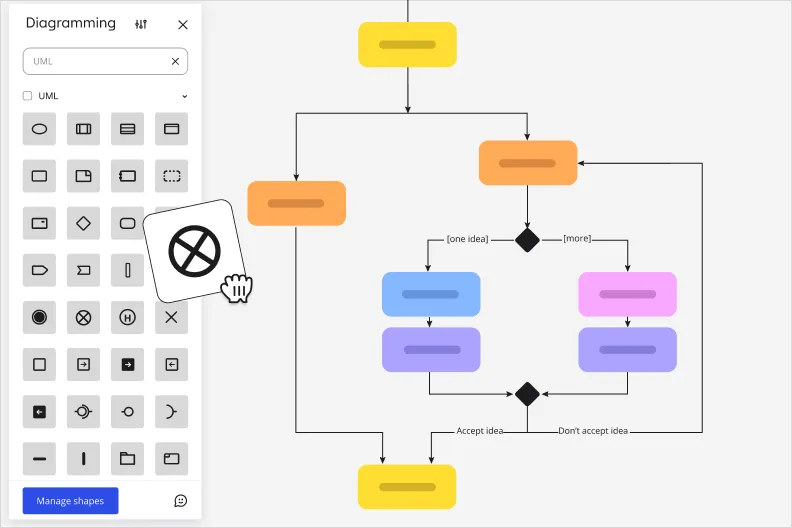วิธีที่ดีกว่าในการแมปข้อมูลสำคัญทางธุรกิจ
เชื่อมโยงทีม ปรับปรุงกระบวนการทางธุรกิจ และปรับขนาดองค์กรของคุณ ทั้งหมดนี้เพื่อสร้างสิ่งที่ยิ่งใหญ่ต่อไปด้วยเครื่องมือการแมปกระบวนการของ Miro
ค้นหาช่องโหว่และปรับปรุงกระบวนการ
แมปกระบวนการขององค์กรโดยใช้ Flowcharts, ไดอะแกรม BPMN, แผนผังสายธารคุณค่า และไดอะแกรมแบบเลนว่ายน้ำ เพื่อมุ่งเป้าจุดเจ็บปวดสำคัญและใช้ทรัพยากรให้ดีขึ้น

สื่อสารกลยุทธ์และการเปลี่ยนแปลงอย่างมีประสิทธิภาพ
เห็นภาพแผนธุรกิจและการเปลี่ยนแปลงโดยการแมปข้อมูลสำคัญ จากนั้นสื่อสารอย่างง่ายดายกับทีมของคุณ ประหยัดเวลาให้ตัวเองหลายชั่วโมงโดยการแสดงบริบทที่เกี่ยวข้องทั้งหมดด้วยการบันทึกเชิงโต้ตอบ

จดบันทึกหลักปฏิบัติที่ดีที่สุดเพื่อให้การดำเนินงานมีประสิทธิภาพ
จัดทำมาตรฐานและจัดบันทึกวิธีที่ดีที่สุดในการทำสิ่งต่าง ๆ โดยการฝังแผนที่กระบวนการธุรกิจและแผนผังสายธารคุณค่าลงในเครื่องมือและเว็บไซต์หลายพันรายการ เช่น Confluence, Coda และ Notion

เหตุผลที่มืออาชีพนับล้างใช้ Miro สำหรับการแมปกระบวนการ

ทุกอย่างและทุกคนในพื้นที่ทำงานเดียว
ทีมสามารถแมปเส้นทางของลูกค้า ตรวจทานกระบวนการธุรกิจ และคอยติดตามรายการดำเนินการได้อย่างง่ายดายโดยใช้การผสานรวม Jira

ชุดรูปร่างและเครื่องมือแมปกระบวนการทั้งหมด
ค้นหาชุดรูปร่างมาตรฐานอุตสาหกรรมสำหรับการจัดการโครงการ, การแมปภาพเส้นทางของลูกค้า และการแมปกระบวนการธุรกิจ เช่น Flowcharts, BPMN, แผนผังสายธารคุณค่า และอื่น ๆ อีกมากมาย

นำเข้าแผนที่กระบวนการที่มีอยู่
นำแผนที่กระบวนการที่มีอยู่เข้าสู่ Miro ด้วยการคลิกเพียงไม่กี่ครั้ง นำเข้าจาก Microsoft Visio, Draw.io หรือ Lucidchart

แชร์และจดบันทึกการปรับปรุง
ใช้ Talktrack บันทึกวิดีโอแนะนำและกระตุ้นทีมให้เร็วขึ้นหรือฝังแผนการทำงานโครงการหรือกระบวนการธุรกิจลงใน Confluence โดยตรงเพื่อให้ผู้มีส่วนได้ส่วนเสียเข้าถึงได้
Miro ตอบโจทย์ทุกความต้องการด้านการแมปกระบวนการ
แมปกระบวนการ พัฒนาแผน และกำหนดแนวคิดที่ทุกคนเข้าใจได้
เรียนรู้เพิ่มเติม
วางแผนและสร้างเส้นทางของผู้ใช้ สำรวจความต้องการและความจำเป็น และออกแบบประสบการณ์ที่โดดเด่น
เรียนรู้เพิ่มเติม
นักวิเคราะห์ทางธุรกิจ เจ้าของกระบวนการ และผู้เชี่ยวชาญด้าน IT ทั้งหมดสามารถได้ประโยชน์จากแบบจำลองกระบวนการทางธุรกิจและสัญลักษณ์เพื่อปรับปรุงประสิทธิภาพของกระบวนการ
เรียนรู้เพิ่มเติม
พนักงานของคุณเป็นสินทรัพย์ที่ยิ่งใหญ่ที่สุด ร่างผังองค์กรเพื่อให้เห็นภาพใหญ่และออกแบบเพื่ออนาคต
เรียนรู้เพิ่มเติม
สร้างผังงานอย่างรวดเร็วและทำให้ขั้นตอนการทำงานและกิจวัตรประจำวันของคุณง่ายขึ้น
เรียนรู้เพิ่มเติม
เทมเพลตที่เกี่ยวข้อง
วิเคราะห์และจัดทำเอกสารของกระบวนการและผลลัพธ์ของทีมของคุณ
เรียนรู้เพิ่มเติม
แมปเส้นทางของลูกค้าเพื่อออกแบบประสบการณ์ที่ดีที่สุดและตอบสนองความต้องการของลูกค้าของคุณ
เรียนรู้เพิ่มเติม
ปรับปรุงกระบวนการและขยายขนาดธุรกิจ
เรียนรู้เพิ่มเติม
สร้างความกระจ่างชัดเกี่ยวกับกระบวนการต่าง ๆ ของคุณ และระบุบทบาทและหน้าที่ความรับผิดชอบต่าง ๆ ด้วยเทมเพลตไดอะแกรมแบบเลนว่ายน้ำ (Swimlane diagram)
เรียนรู้เพิ่มเติม
ระบุและปรับปรุงประสิทธิภาพของขั้นตอนต่าง ๆ ในการพัฒนาผลิตภัณฑ์โดยใช้กระบวนการคิดแบบลีน (Lean methodology)
เรียนรู้เพิ่มเติม
เทมเพลตเวิร์กโฟลว์ทำให้การทำงานร่วมกันเป็นเรื่องง่าย ช่วยให้คุณติดตามสถานะโครงการและดูความคืบหน้าของทีมได้ทันที เป็นเครื่องมือที่ยอดเยี่ยมสำหรับทีมออกแบบระยะไกลและแบบผสมผสาน
เรียนรู้เพิ่มเติม

คำถามที่พบบ่อยเกี่ยวกับเครื่องมือการแมปกระบวนการ
เครื่องมือการแมปกระบวนการของ Miro เหมาะกับใคร
ใคร ๆ ก็สามารถวาดไดอะแกรมใน Miro ได้ ไม่ว่าคุณจะเป็นนักวิเคราะห์ธุรกิจ ทำงานอยู่ในฝ่ายปฏิบัติการ หรือเป็นหัวหน้าทีม Miro นำเสนออินเทอร์เฟซที่ใช้งานและเข้าใจง่าย ซึ่งทำให้ทุกคนสามารถเข้าถึงและเข้าใจแผนที่กระบวนการและเส้นทางของลูกค้าได้อย่างง่ายดาย แต่ทรงพลังเพียงพอสำหรับผู้เชี่ยวชาญที่จะเจาะลึกลงไปอีก นอกจากนี้ยังมีรูปร่างการแมปกระบวนการที่หลากหลายในไลบรารีที่กว้างขวางของ Miro ดังนั้นคุณจะพบสิ่งที่คุณต้องการเพื่อสร้างสิ่งที่ยิ่งใหญ่ชิ้นต่อไป
เครื่องมือการแมปกระบวนการของ Miro เป็นผลิตภัณฑ์แยกต่างหากหรือไม่
ไม่ ใน Miro ทุกอย่างเกิดขึ้นในที่เดียวตั้งแต่การระดมสมองไปจนถึงการแมปกระบวนการและการแชร์ ด้วยวิธีนี้ คุณจะมีข้อมูลทั้งหมดอยู่ในที่เดียว และทุกคนจะมีบริบทที่ต้องการอยู่เสมอ
แผนที่กระบวนการสามารถนำเข้าจากเครื่องมืออื่นได้หรือไม่
ใช่ คุณสามารถนำเข้าไฟล์ .vsdx เข้าใน Miro ได้จาก Lucidchart, Microsoft Visio และ Draw.io เมื่อมีแผนที่กระบวนการใน Miro คุณและทีมทั้งหมดสามารถตรวจสอบ ดำเนินการ และทำงานร่วมกันในพื้นที่ทำงานเดียวที่ทุกคนสามารถเข้าถึงได้
การแชร์แผนที่กระบวนการกับผู้อื่นมีวิธีการอย่างไร
มีอยู่หลายวิธี คุณสามารถแชร์บอร์ดกับผู้คนในทีมของคุณ แม้แต่แขกและผู้เยี่ยมชม คุณสามารถฝังแผนที่กระบวนการลงในเครื่องมืออย่าง Confluence และส่งออกเป็น PDF ได้
อ่านเพิ่มเติม
เริ่มใช้งานในไม่กี่วินาที
เข้าร่วมทีมงานนับพันโดยใช้ Miro เพื่อทำงานให้ดีที่สุด




